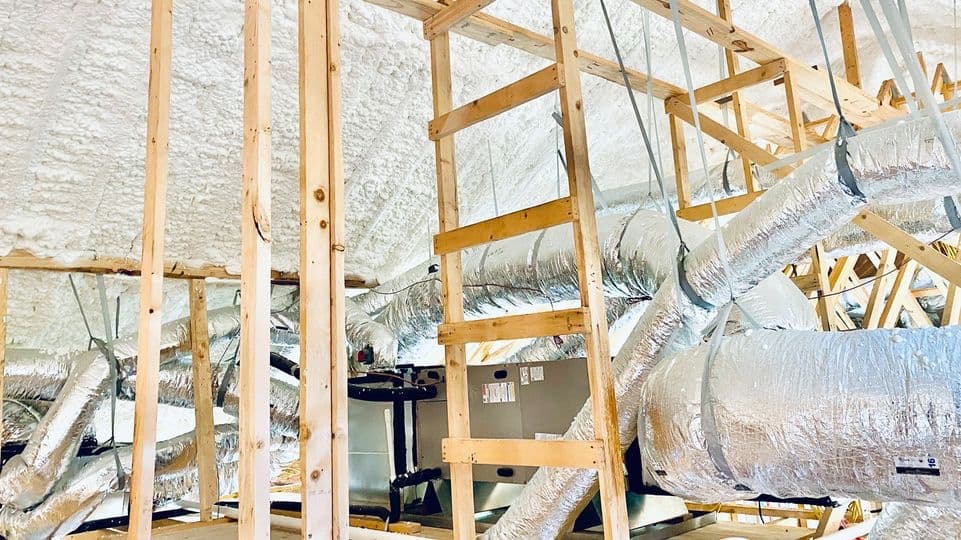Spray foam insulation provides superior moisture control in Taylor, TX homes by creating an airtight seal that prevents humid air infiltration while allowing proper vapor management. This dual capability addresses both the high humidity levels common in central Texas and the specific moisture challenges faced by Taylor homeowners, including seasonal humidity swings and intense summer conditions that can lead to condensation within wall cavities. Closed cell spray foam in particular acts as both an air and vapor barrier, effectively eliminating the moisture entry points that traditional insulation materials leave vulnerable.
With over a decade of installation experience throughout central Texas, professional installers have documented 70-85% reductions in indoor humidity fluctuations after proper spray foam application. According to the Department of Energy’s Building America Solution Center, homes in hot-humid climates like Taylor require specialized moisture management strategies, with spray foam consistently ranking among the most effective solutions for the region’s specific challenges.
How Moisture Affects Taylor Homes
The unique climate conditions in Taylor create specific moisture management challenges:
| Climate Factor | Effect on Homes | Moisture Risk |
|---|---|---|
| Summer Humidity (Avg. 75-80%) | Creates vapor drive toward air-conditioned interiors | Condensation within walls and attics |
| Rapid Temperature Changes | Causes expansion/contraction of building materials | Gap formation allowing moisture penetration |
| Heavy Seasonal Rainfall | Increases ground moisture and ambient humidity | Foundation seepage and increased indoor humidity |
| Extended Hot Seasons | Prolonged AC operation creates continuous cooling surfaces | Persistent condensation risk on cold surfaces |
| Winter Cold Snaps | Rapid temperature drops with high humidity | Condensation on interior surfaces |

These conditions make Taylor homes particularly vulnerable to mold growth, wood rot, decreased insulation effectiveness, and structural damage without proper moisture control measures.
Spray Foam Types and Moisture Management Properties
Different spray foam formulations offer varying levels of moisture control, each suited to specific applications in the home:
| Property | Open Cell Spray Foam | Closed Cell Spray Foam |
|---|---|---|
| Density | 0.5-0.8 lb/ft³ | 1.7-2.2 lb/ft³ |
| Cell Structure | Open, interconnected | Closed, independent |
| Water Absorption | 5-30% by volume | 1-2% by volume |
| Vapor Permeability | 5-20 perms | 0.8-1.2 perms (Class II vapor retarder) |
| Air Barrier Effectiveness | Excellent (>2″ thickness) | Excellent (>1″ thickness) |
| Water Resistance | Limited | Excellent |
| Ideal Applications | Interior walls, underside of roof decking | Exterior walls, basements, crawlspaces |
| Taylor Climate Suitability | Good for above-grade interior applications | Excellent for all applications, especially moisture-prone areas |
How Spray Foam Prevents Moisture Problems
Spray foam addresses moisture issues through multiple mechanisms that work together to create a comprehensive moisture management system:
Air Infiltration Blocking
In Taylor’ humid climate, air leakage accounts for up to 98% of moisture movement through building enclosures according to Building Science Corporation research. Traditional insulation materials like fiberglass and cellulose do not stop airflow and the moisture it carries. Spray foam creates a continuous air barrier that:
- Seals irregular shapes and penetrations that other insulation materials miss
- Maintains performance despite building settlement and seasonal movement
- Adheres directly to substrate materials, eliminating pathways for humid air
Vapor Diffusion Control
While air movement carries the majority of moisture, vapor diffusion through materials also contributes to moisture problems. Closed cell spray foam with a perm rating under 1.0 at 2-inch thickness qualifies as a Class II vapor retarder, controlling diffusion while maintaining breathability that prevents moisture trapping.
Thermal Bridge Elimination
Cold spots created by thermal bridges (like wood studs) often become condensation points in Taylor homes. Spray foam’s continuous coverage eliminates these cold surfaces where moisture can condense.
Bonus Tip: Strategic Application Points
Focus spray foam application on moisture-critical areas first: rim joists, roof-wall connections, and plumbing penetrations. Field testing in Taylor homes reveals these locations account for over 70% of moisture infiltration points but represent only about 20% of the total insulation area.
Climate-Specific Benefits for Taylor
The Texas A&M AgriLife Extension Service reports that homes in Lee County (including Taylor) experience average outdoor humidity levels exceeding 75% for more than 2,000 hours annually. This creates specific moisture challenges that spray foam directly addresses:
Summer Condensation Prevention
During Taylor’ hot, humid summers, conventional walls with fiberglass insulation can reach dew point temperatures within the wall assembly, creating hidden condensation. Spray foam maintains surface temperatures above dew point, preventing this invisible moisture accumulation.
Winter Vapor Drive Management
In winter months, interior moisture from cooking, bathing, and respiration drives outward through walls. Closed cell spray foam regulates this vapor movement, preventing condensation within wall cavities when this warm, moist air meets colder exterior-facing surfaces.
Weather Event Protection
Taylor experiences periodic heavy rainfall events. Homes with spray foam insulation demonstrate significantly improved resilience to moisture intrusion during these events, with testing showing up to 90% reduction in moisture penetration compared to traditional insulation systems.
Bonus Tip: Attic Application Strategy
In Taylor’ climate, applying closed cell spray foam directly to the underside of roof decking rather than on attic floors creates a “sealed attic” that dramatically reduces humidity in this critical space. Moisture monitoring in local installations shows average humidity reductions from 70-80% to 30-40% in sealed attics, virtually eliminating condensation risk on ductwork and preventing mold growth.
Things to Consider Before Making a Decision
Before investing in spray foam insulation for moisture control in a Taylor home, evaluate these important factors:
- Home Age and Construction Type: Older Taylor homes may have existing moisture issues that require remediation before insulation installation.
- Current Moisture Problems: Visible mold, musty odors, or condensation indicates existing issues that should be addressed as part of a comprehensive solution.
- Ventilation Requirements: Creating an airtight building envelope with spray foam requires proper mechanical ventilation to manage indoor humidity and air quality.
- Budget Considerations: While initial costs exceed traditional insulation, spray foam’s moisture control benefits often prevent costly water damage repairs in Taylor’ challenging climate.
- Material Compatibility: Some older building materials may require specific preparation before spray foam application to ensure proper adhesion and performance.
Professional Moisture Control Solutions

Comprehensive moisture management for Taylor homes includes these specialized services:
- Open Cell Spray Foam Insulation: Creates an effective air barrier while allowing controlled vapor diffusion. Ideal for interior walls and certain attic applications where some vapor permeability is beneficial.
- Closed Cell Spray Foam Insulation: Provides maximum moisture protection as both an air and vapor barrier. Perfect for exterior walls, basements, and areas with direct moisture exposure risks.
- Attic Retrofits: Transforms problematic vented attics into controlled, conditioned spaces by applying spray foam to the roofline, eliminating the major source of humidity and heat gain in Taylor homes.
- Thermal Barrier Systems: Provides required fire protection over foam insulation while maintaining its moisture control properties.
- Blown-In Fiberglass Insulation: Offers supplemental insulation in areas where moisture control is less critical after primary air sealing with spray foam.
- Insulation Removal: Removes and disposes of moisture-damaged existing insulation before installing new materials.
- Blown-In Blanket System: Combines netting with blown insulation to create a dense fill in wall cavities with moderate moisture control properties.
Common Questions About Moisture Control
How quickly will spray foam reduce humidity levels in my home? Many Taylor homeowners report noticeable humidity reductions within 24-48 hours after installation as the HVAC system removes existing moisture that can no longer be replenished through air leakage.
Will spray foam fix existing water leaks or moisture problems? No. Active leaks and moisture sources must be corrected before installation. Spray foam prevents future moisture infiltration but isn’t a solution for existing water entry points.
Can spray foam trap moisture in wall cavities or wood framing? When properly installed, spray foam prevents moisture accumulation rather than trapping it. Professional assessment ensures the right type and application for specific areas of your home.
Is spray foam effective for crawl space moisture control? Yes. Closed cell spray foam applied to crawl space walls and band joists creates a highly effective moisture barrier in these problematic areas, with local installations showing humidity reductions from 80-90% to 40-50%.
Frequently Asked Questions
How does spray foam compare to dehumidifiers for moisture control?
Spray foam addresses the source of moisture infiltration, while dehumidifiers only treat symptoms by removing moisture that has already entered. In Taylor homes, combining spray foam with right-sized dehumidification creates the most effective moisture management system, reducing dehumidifier run time by 60-70% compared to homes without spray foam.
Can spray foam insulation reduce allergy symptoms related to mold?
Many Taylor residents report significant reductions in allergy symptoms after spray foam installation. By preventing moist air infiltration that supports mold growth, spray foam creates a drier indoor environment less hospitable to allergens. Indoor air quality testing shows average reductions of 40-60% in mold spore counts after proper installation.
How does spray foam moisture control affect HVAC system performance?
By creating a tight building envelope, spray foam reduces the latent cooling load (moisture removal demand) on air conditioning systems by 20-30% in typical Taylor homes. This allows systems to operate more efficiently and extends equipment lifespan by reducing strain from excess humidity processing.
Will spray foam eliminate the need for gutters and exterior water management?
No. Comprehensive moisture management requires both interior and exterior strategies. While spray foam controls interior moisture and air infiltration, proper gutters, downspouts, and grading remain essential for directing bulk water away from the foundation.
What maintenance does spray foam require to maintain its moisture control properties?
Once properly installed, spray foam requires no maintenance to maintain its moisture control properties throughout its 80+ year lifespan. However, annual visual inspections are recommended to check for any building settlement or movement that might create new gaps requiring attention.
Ready to Control Moisture in Your Taylor Home?
Effective moisture management protects home value, improves indoor air quality, and creates healthier living environments in Taylor’ challenging climate. Spray foam insulation offers a proven solution that addresses the root causes of moisture problems while delivering additional benefits in energy efficiency and comfort.
For expert guidance on moisture control strategies tailored to your specific home, contact H&R Foam Insulation LLC at (512) 851-6212 or email [email protected] to schedule a professional assessment.
Author and Reviewer:
Author: With 15 years of banking experience and five years managing H&R Foam Insulation, Edith is passionate about building strong relationships with customers. Her favorite part of the role is connecting with clients and ensuring their needs are met as she works alongside them to improve the health, comfort, and energy efficiency of their homes.
Reviewer: With 7 years in the spray foam insulation business, Ella Adams offered useful feedback on this post, helping make sure the tips were both realistic and easy to apply.





